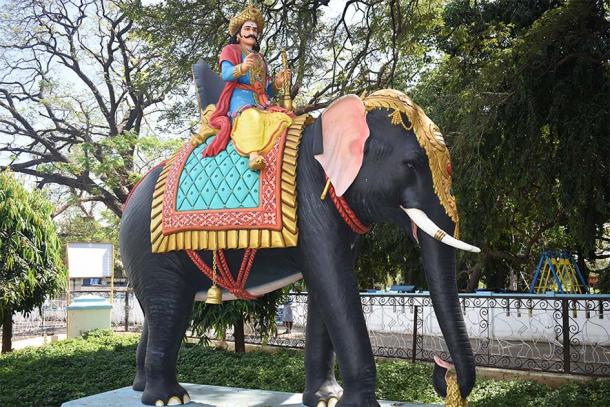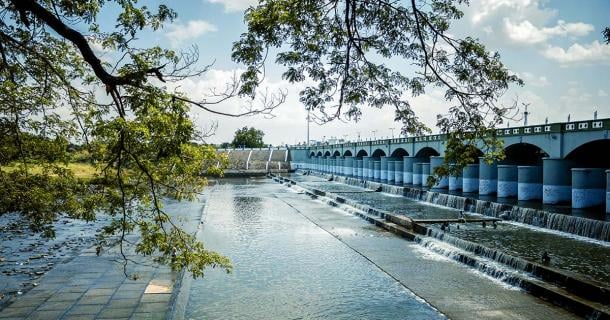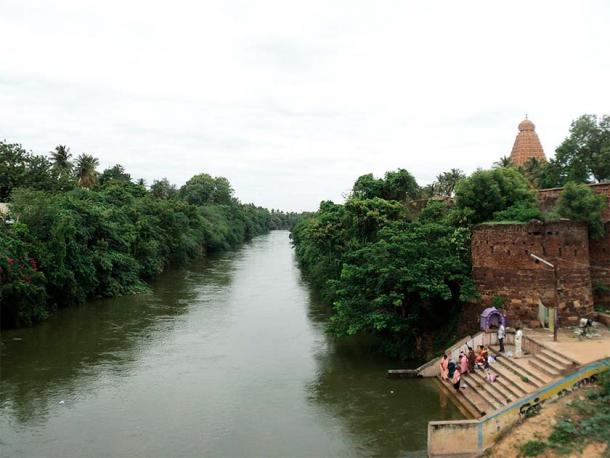
2,000-year-old Kallanai Dam: Timeless Engineering Marvel of the Chola Dynasty
Sometimes, ancient marvels of architecture simply defy all forms of logic. And even after many centuries pass, and the world enters the modern age, we are amazed to see these ancient jewels still going strong and having an efficient use. One such marvel is the Kallanai Dam, located in modern-day India. For many long centuries it served the locals and brought bountiful crops—and continues to do so to this very day. How can that be? How did ancient Tamil architects create such an industrial marvel that was centuries ahead of its time? And more than anything, how did it survive so long unscathed?

Statue of the visionary Chola king Karikalan, whose brainchild was the Kallanai Dam. (Elamaran Elaaa / Adobe Stock)
Kallanai Dam as the Heritage of Tamil Kings
Kallanai Dam, also known colloquially as Grand Anicut, stands as an architectural marvel deeply rooted in the rich historical tapestry of southern India. Nestled along the meandering course of the Kaveri River in the state of Tamil Nadu, this truly venerable structure represents an enduring testament to the ingenuity of ancient engineering, dating back over two millennia.
- Hydrologic Engineering Marvels Hidden in History
- How Ancient Kings Split a River & Fed Millions (Video)
Attributed to the visionary Chola king Karikalan around the 2nd century AD, the genesis of Kallanai Dam unfolded with the ambitious objective of harnessing the abundant waters of the Kaveri River for agricultural prosperity. The very name Kallanai derives its etymology from the Tamil words alam and anai, translating to “stone” and “dam” respectively. Crafted without the aid of modern construction materials such as mortar, this monumental edifice stands as a testament to the Cholas’ sophisticated engineering capabilities.
The primary purpose of the dam was to divert the life-giving waters of the Kaveri into the fertile delta region, facilitating an extensive irrigation network that transformed arid lands into verdant fields. The Cholas’ meticulous planning and execution of the dam played a pivotal role in bolstering agricultural yields, thereby contributing significantly to the economic prosperity of the region.

Modern-day view of the Kallanai Dam or Grand Anicut. (Premnath Thirumalaisamy / CC BY-NC 2.0 DEED)
Kallanai Dam is a Marvel of Tamil Architecture
The physical dimensions of Kallanai Dam are awe-inspiring, spanning approximately 329 meters (1,080 feet) in length and 20 meters (66 feet) in width. The dam comprises three distinct sections—the Kudamuruti, the Periyar and the Viranam—each designed to serve a specific function in regulating the flow of water. Noteworthy is the absence of mortar in the construction, relying on the precision of interlocking stone blocks to withstand the forces of the river.
Enduring the ravages of time, Kallanai Dam has not merely stood as a stoic structure but has evolved through centuries of maintenance and renovations by successive dynasties. Today, it continues to be a vital component of the region's agricultural landscape, ensuring a consistent water supply for the cultivation of crops. This, of course means that the dam is one of the oldest in the world that is still in active use.
Beyond its utilitarian significance, Kallanai Dam holds profound cultural and historical importance. It is not merely a functional water management system but a living relic that resonates with the foresight and strategic acumen of the Chola Dynasty. In recognition of its historical and architectural significance, the dam has become a revered tourist destination, drawing visitors who seek to marvel at the intersection of ancient engineering and environmental sustainability.

Grand Anicut Canal System starts at the right flank of the Kallanai Dam, also known as the Grand Anicut, in South India. (PP Yoonus / CC BY-SA 3.0)
Kallanai Dam Will Be in Use for Generations to Come
It is always inspiring to see ancient structures still being in use and efficiently at that. This marvel of ancient architecture has been attributed to Karikala the Great, a Tamil king of the Chola Dynasty, who reigned in the 2nd century AD. Karikala, known as one of the greatest Tamil kings of the Early Chola period, recognized the potential of the overflowing and bountiful Kaveri River. So, he ordered the construction of the dam, thus creating fertile land in its surroundings, ensuring that his vast realm could feed all its people.
- 10 Jaw-dropping Engineering Marvels of the Inca Empire
- Sticky Rice Mortar Used in Ancient Chinese Architecture
Of course, the Kallanai Dam is not completely original, as it was in Karikala’s time. Subsequent rulers, across the centuries, maintained the dam, added to it and ensured that it worked without problems and without succumbing to time. Still, when all is said and done, Kallanai Dam is undoubtedly one of the oldest in the world. And its impact on the fertility of the surrounding lands was so great, that Karikala’s name had been etched in the history of the region, never to be forgotten.
Today, Kallanai Dam stands tall as a monumental embodiment of ancient engineering brilliance, a manifestation of the Chola Dynasty's vision to harness natural resources for the collective benefit of society. Its enduring legacy not only underscores the critical role of sustainable water management in the historical context but also serves as a living bridge connecting the past with the present. It truly is one of the ancient marvels of the world.
Top image: Modern-day view of Kallanai dam in India. Source: Elamaran Elaaa / Adobe Stock
References
Balaganessin, M. 29 Agosto 2011. “Flowing waters for fertile fields” in The Hindu. Available at: https://www.thehindu.com/features/kids/flowing-waters-for-fertile-fields/article2408778.ece
Unknown. No date. “Kallanai Dam” in Thanjavur Tourism. Available at: https://www.thanjavurtourism.com/kallanai-dam.html
Unknown. 26 August 2013. “Incredible India! A 2,000-year-old functional dam” in India Today. Available at: https://www.indiatoday.in/world/story/incredible-india-2000-year-old-functional-dam-india-today-175057-2013-08-25















